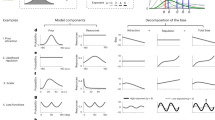Abstract
GREGORY1 and Cane and Gregory2 have put forward a theoretical equation for the brightness increment threshold considered as a statistical discrimination. For a given frequency of detection they propose that:  where (r + Δr), r, are the mean neural pulse-rates associated with the intensities (I + ΔI), I, and V is the variance of these rates. C is a constant necessary to account for the occurrence of fewer than 50 per cent false positives. Its implication, as stated by Gregory, is that “some fixed difference between impulse rates is required before discrimination is established, this difference being independent of the intensity I”.
where (r + Δr), r, are the mean neural pulse-rates associated with the intensities (I + ΔI), I, and V is the variance of these rates. C is a constant necessary to account for the occurrence of fewer than 50 per cent false positives. Its implication, as stated by Gregory, is that “some fixed difference between impulse rates is required before discrimination is established, this difference being independent of the intensity I”.
This is a preview of subscription content, access via your institution
Access options
Subscribe to this journal
Receive 51 print issues and online access
$199.00 per year
only $3.90 per issue
Buy this article
- Purchase on Springer Link
- Instant access to full article PDF
Prices may be subject to local taxes which are calculated during checkout
Similar content being viewed by others
References
Gregory, R. L., in Information Theory, Third London Symposium, ed. by Cherry (1956).
Gregory, R. L., and Cane, V., Nature, 176, 1272 (1955).
Thurstone, L. L., Psychol. Rev., 34, 273 (1927).
Marriott, F. H. C., Nature, 181, 1488 (1958).
Tanner, jun., W. P., and Swets, J. A., Psychol. Rev., 61, 401 (1954).
Author information
Authors and Affiliations
Rights and permissions
About this article
Cite this article
TREISMAN, M. Theory of the Visual Threshold. Nature 189, 1031–1032 (1961). https://doi.org/10.1038/1891031b0
Issue Date:
DOI: https://doi.org/10.1038/1891031b0
Comments
By submitting a comment you agree to abide by our Terms and Community Guidelines. If you find something abusive or that does not comply with our terms or guidelines please flag it as inappropriate.



